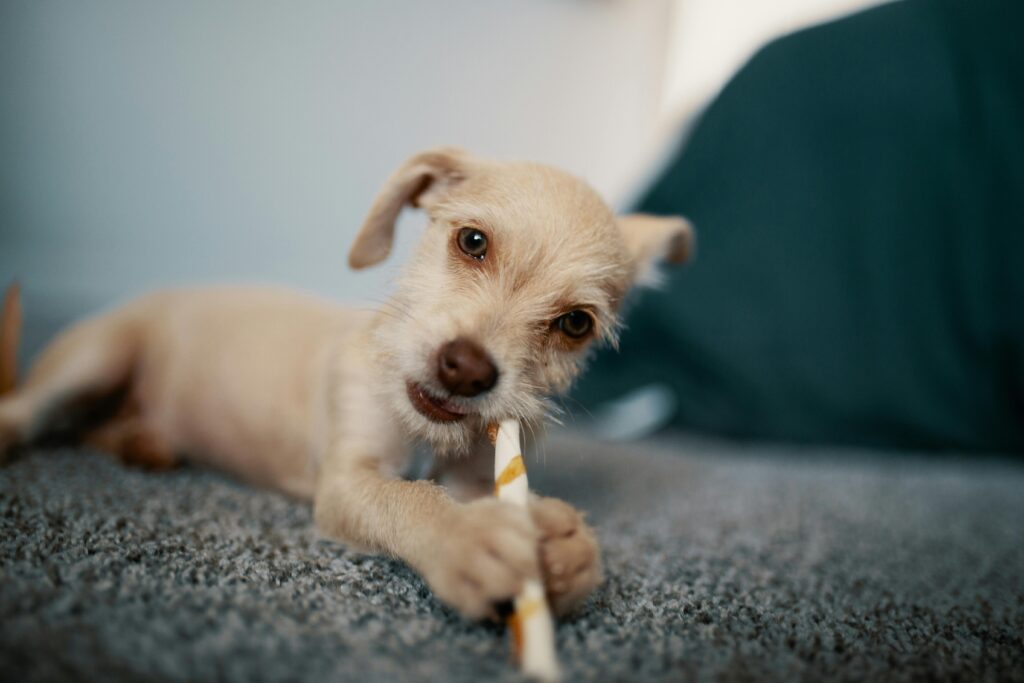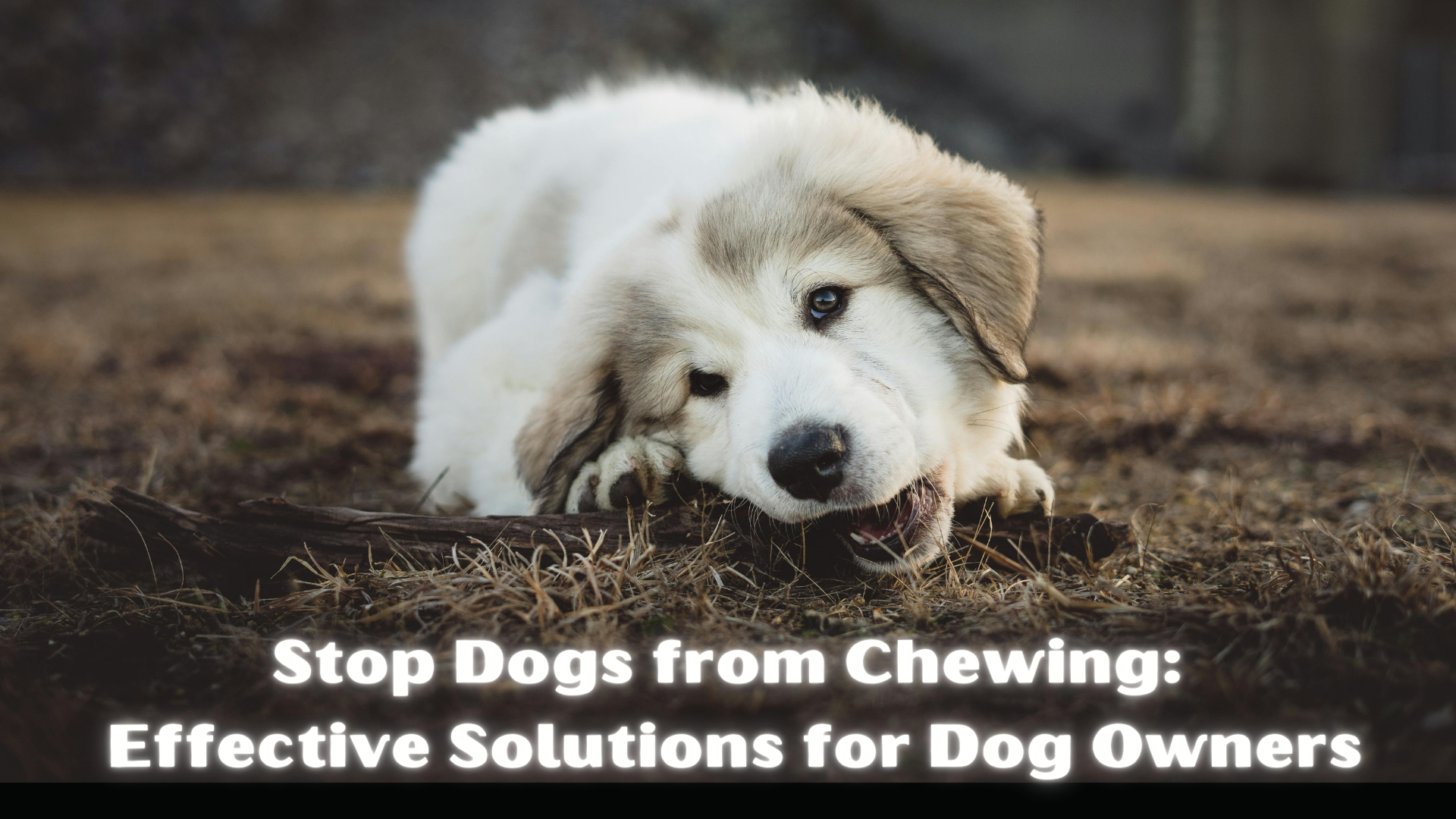Managing a dog’s chewing habits is a common challenge for pet owners. While chewing is natural, it can lead to frustration when household items become chew toys. Understanding why dogs and puppies chew is essential for addressing unwanted behaviors effectively.
In this comprehensive guide, we’ll explore the reasons behind chewing and provide practical strategies to help you stop it. From offering appropriate chew toys to implementing training techniques, we’ll cover all you need to keep your home chew-free.
To further assist you, don’t forget to download our free EBook, filled with expert tips and insights on managing your dog’s behavior. Click the link at the end of the article to get your copy today!

Table of Contents
- Understanding Dog Chewing: Reasons and Implications
- How to Stop Dogs from Chewing: Effective Techniques
- How to Keep a Dog from Chewing: Preventative Measures
- How to Stop Puppy from Chewing: Tailored Strategies
- How to Keep Puppies from Chewing: Best Practices
- Stop Puppy Chewing: Common Challenges and Solutions
- Conclusion: Free EBook for Further Insights
Understanding Dog Chewing: Reasons and Implications
Chewing is a natural and instinctive behavior for dogs that serves several purposes. Understanding why dogs chew can help pet owners effectively address unwanted chewing habits. Here are the primary reasons dogs engage in chewing:
Exploration and Learning
For puppies, chewing is a way to explore their environment. Just as human infants learn about the world through their mouths, puppies use chewing to understand the textures, tastes, and functions of various objects. This exploratory chewing is essential for their cognitive development.
Teething Relief
Puppies go through a teething phase, usually between three to six months of age. During this time, their gums may be sore as adult teeth begin to come in. Chewing helps alleviate this discomfort, making it crucial for puppy owners to provide appropriate chew toys.
Boredom and Lack of Stimulation
Dogs, especially those left alone for long periods, may chew out of boredom. When they don’t have enough physical and mental stimulation, they can resort to destructive behaviors to occupy their time. This is particularly common in high-energy breeds that require more activity than others.
Anxiety and Stress Relief
Many dogs experience anxiety, whether from separation, loud noises, or changes in their environment. Chewing can serve as a coping mechanism for dogs dealing with stress or anxiety. It is essential for dog owners to recognize this behavior and address the underlying causes of their dog’s anxiety.
Attention-Seeking Behavior
Sometimes, dogs chew to gain attention from their owners. Whether they receive positive or negative attention, dogs may learn that chewing on household items can prompt a reaction from their humans. This reinforces the behavior and can lead to more chewing problems if not corrected.
By understanding these motivations behind chewing, owners can tailor their approaches to effectively address and prevent unwanted chewing behavior.
How to Stop Dogs from Chewing: Effective Techniques
Addressing destructive chewing involves a multi-faceted approach. Here are some effective techniques to help stop dogs from chewing on inappropriate items:
1. Provide Appropriate Chew Toys
Investing in a variety of durable, safe chew toys is one of the best ways to redirect your dog’s chewing behavior. Look for toys that are designed specifically for dogs and cater to their chewing styles. Chew toys can vary from rubber to nylon to natural materials, ensuring you have options that suit your dog’s preferences. Rotating toys can keep your dog engaged and reduce boredom.
2. Establish a Routine
Dogs thrive on routine. Creating a consistent daily schedule can significantly reduce anxiety-related chewing. Include regular exercise, playtime, and training sessions in your routine. A well-exercised dog is less likely to engage in destructive chewing.
3. Use Deterrent Sprays
For items you want to protect, consider using bitter-tasting deterrent sprays. These sprays are designed to make furniture and belongings unappealing to your dog. Apply them to items that are frequently chewed, and with time, your dog will learn to avoid those objects.
4. Redirect Behavior
When you catch your dog chewing on something they shouldn’t, calmly redirect them to an appropriate chew toy. This teaches them what is acceptable to chew on. Be consistent with this approach and reward them when they engage with the right toys.
5. Training Commands
Teaching your dog commands like “leave it” and “no” can be extremely effective. When your dog begins to chew on an inappropriate item, use the command to interrupt the behavior. Always reward them when they comply, reinforcing positive behavior.
6. Engage in Interactive Play
Regular playtime not only strengthens your bond with your dog but also helps to burn off excess energy. Engage in games like fetch, tug-of-war, or hide-and-seek. This interactive play can keep your dog mentally stimulated and less likely to resort to chewing.
How to Keep a Dog from Chewing: Preventative Measures
Preventing chewing behavior before it starts is critical for dog owners. Here are some essential preventative measures to consider:
1. Limit Access to Temptations
Keep personal belongings, shoes, and other tempting items out of your dog’s reach. Designate specific areas in your home where your dog is allowed and ensure that any valuable or dangerous items are stored safely away.
2. Increase Exercise and Mental Stimulation
A well-exercised dog is less likely to engage in destructive chewing. Ensure your dog has regular walks, playtime, and interactive games that challenge their mind. Consider activities like agility training, obedience classes, or puzzle toys to provide mental stimulation.
3. Socialization
Regular socialization with other dogs can reduce anxiety and boredom, common causes of chewing. Organizing playdates or taking your dog to dog parks can help them learn appropriate behaviors from their peers.
4. Provide Environmental Enrichment
Creating a stimulating environment can help keep your dog engaged and reduce boredom. Use toys that dispense treats, interactive games, or even set up an agility course in your backyard. The more engaged your dog is, the less likely they will resort to unwanted chewing.
How to Stop Puppy from Chewing: Tailored Strategies
Stopping a puppy from chewing requires specific approaches tailored to their developmental needs. Here are strategies that can help:
1. Supervised Play
Always supervise your puppy during playtime to prevent them from chewing on unsuitable items. If you catch them chewing something inappropriate, calmly redirect them to an acceptable toy.
2. Offer Teething Aids
Provide a variety of teething toys designed specifically for puppies. These toys can help soothe their sore gums and provide a safe outlet for their chewing needs.
3. Consistent Training
Establishing consistent training from an early age is essential in curbing chewing habits. Use positive reinforcement techniques to reward your puppy when they choose appropriate chew items.
4. Crate Training
Crate training can be an effective method for managing a puppy’s chewing behavior. When you cannot supervise them, placing your puppy in a crate with safe chew toys can prevent destructive chewing and create a safe environment.
5. Create a Chew Schedule
Establish specific times for your puppy to engage with their chew toys. This structure helps them learn when and what is appropriate to chew on, reinforcing good habits.
How to Keep Puppies from Chewing: Best Practices
Keeping puppies from developing destructive chewing habits involves proactive measures. Here are best practices to follow:
1. Establish Clear Boundaries
From the moment you bring your puppy home, set clear boundaries about what items are off-limits for chewing. Consistency is key; make sure everyone in the household is on the same page.
2. Interactive and Engaging Toys
Provide a variety of interactive toys that stimulate your puppy’s mind. Puzzle toys that dispense treats can keep them occupied and less likely to chew on household items.
3. Consistent Routine
Maintain a daily routine that includes plenty of physical and mental stimulation. This structure can help reduce anxiety and decrease the likelihood of chewing.
4. Teach Commands Early
Teaching commands such as “leave it” and “no” from an early age can significantly reduce unwanted chewing. Reinforce these commands with treats and praise when your puppy responds correctly.

Stop Puppy Chewing: Common Challenges and Solutions
New puppy owners often face challenges in curbing chewing behaviors. Here are solutions to common issues:
1. Boredom-Driven Chewing
If your puppy is chewing out of boredom, increase their activity level. More playtime, training sessions, and regular walks can keep them engaged and reduce destructive behaviors.
2. Attention-Seeking Chewing
If your puppy chews to get attention, avoid giving them any attention when they engage in this behavior. Instead, redirect them to a toy and reward them when they chew on something appropriate.
3. Inconsistent Rules
Ensure all family members enforce the same rules regarding chewing. Consistency helps your puppy learn what behaviors are acceptable and what items are off-limits.
4. Patience and Understanding
Understand that chewing is a natural behavior, especially for puppies. Be patient and remain consistent in your training approach. Over time, with the right strategies, your puppy will learn to distinguish between acceptable and unacceptable items to chew.
Conclusion: Free EBook for Further Insights
In conclusion, understanding why dogs and puppies chew, along with implementing effective strategies, is essential for maintaining a happy and harmonious home. By addressing the root causes of chewing and providing appropriate outlets for this behavior, you can significantly reduce the likelihood of destructive chewing.
To gain deeper insights and discover additional strategies for managing your dog’s behavior, we invite you to download our free EBook filled with expert tips. Download Your Free EBook Here

